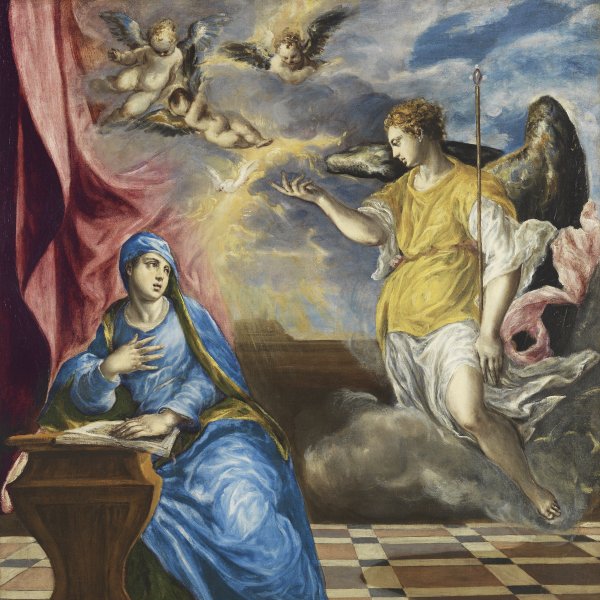The Immaculate Conception
ca. 1608 - 1614
Oil on canvas.
108 x 82 cm
Museo Nacional Thyssen-Bornemisza, Madrid
Inv. no.
170
(1930.29
)
Not exhibited
Level 2
Permanent Collection
Level 1
Permanent Collection
Level 0
Carmen Thyssen Collection and Temporary exhibition rooms
Level -1
Temporary exhibition rooms, Conference room and EducaThyssen workshop
The Immaculate Conception entered the Collection in 1929. It was previously in the collection of Marczell von Nemes in Budapest. According to Heinemann the oldest known reference to the canvas locates it in a private collection in Cadiz. From there it entered the Madrid collection of Miguel Borondo, that of the Marquis of Casa Torres in 1902, the Marquis of Vega-Inclán, and that of Luis de Navas in Madrid in 1908, before it passed to Hungary. The canvas was first published and illustrated in 1906 and appeared in all the catalogues of the Collection since that of the Munich exhibition of 1930. In the early literature it was described as an Assumption, an error corrected by Mayer in 1911.
The painting has been compared to two others on this subject by the artist, of which the earlier is The Immaculate Conception watched by Saint John the Evangelist, painted for the church of San Román in Toledo. Dated to around 1580–85, in that work El Greco depicted a tall, elegant Virgin in the sky framed by musical angels and resting on cherubim. In the lower zone with the figure of Saint John, the artist included a landscape in which the traditional symbols of the Virgin become additional elements in the view for the first time. The second version, which is much later and closer to the present one, is dated to between 1608 and 1613 and is known as the Oballe Immaculate Conception after the chapel for which it was painted. In that work the artist re-interpreted the subject, placing greater emphasis on the cloud of glory and the angels and cherubim around the Virgin, and as a result creating a much more ethereal effect than in earlier versions. Gudiol suggested that the present canvas might have been a preliminary idea for the Oballe chapel version. Having studied these various versions, however, Álvarez Lopera concluded that the present canvas is a later re-thinking of the San Román composition, painted with greater compositional dynamism and clarity regarding the work’s doctrinal message.
With regard to the execution of the painting, the first author to suggest that it may have involved the participation of El Greco’s son Jorge Manuel was Soehner who noted a difference in quality between the figures and the landscape, attributing the latter to Jorge Manuel. Wethey compared this canvas to the Oballe Immaculate Conceptionand consequently catalogued it as having workshop participation. Cossío emphasised the difference in the handling of the background and figures, as did Álvarez Lopera, who attributed it to El Greco with the collaboration of Jorge Manuel.
Mar Borobia
The painting has been compared to two others on this subject by the artist, of which the earlier is The Immaculate Conception watched by Saint John the Evangelist, painted for the church of San Román in Toledo. Dated to around 1580–85, in that work El Greco depicted a tall, elegant Virgin in the sky framed by musical angels and resting on cherubim. In the lower zone with the figure of Saint John, the artist included a landscape in which the traditional symbols of the Virgin become additional elements in the view for the first time. The second version, which is much later and closer to the present one, is dated to between 1608 and 1613 and is known as the Oballe Immaculate Conception after the chapel for which it was painted. In that work the artist re-interpreted the subject, placing greater emphasis on the cloud of glory and the angels and cherubim around the Virgin, and as a result creating a much more ethereal effect than in earlier versions. Gudiol suggested that the present canvas might have been a preliminary idea for the Oballe chapel version. Having studied these various versions, however, Álvarez Lopera concluded that the present canvas is a later re-thinking of the San Román composition, painted with greater compositional dynamism and clarity regarding the work’s doctrinal message.
With regard to the execution of the painting, the first author to suggest that it may have involved the participation of El Greco’s son Jorge Manuel was Soehner who noted a difference in quality between the figures and the landscape, attributing the latter to Jorge Manuel. Wethey compared this canvas to the Oballe Immaculate Conceptionand consequently catalogued it as having workshop participation. Cossío emphasised the difference in the handling of the background and figures, as did Álvarez Lopera, who attributed it to El Greco with the collaboration of Jorge Manuel.
Mar Borobia









